
After surviving polio as a six-year-old, Sandy Taylor took up spinning and weaving to get her fingers moving.
At nearly 80, her hands deftly rise and fall as she weaves white thread in the intricate art of lace making.
"I can't paint, I can't draw but I can create with any type of fibre and fabric," Ms Taylor told AAP.
"It seems to be my natural forte."
She moves 32 wooden bobbins up, down and around to follow a pattern, winding thread around brass pins to create a panel of scalloped lace.
The former textiles teacher is captured by the history of lace dating back to 16th century Europe, when it was made by the poor to become the ultimate luxury for the rich.
For her friend and fellow lace maker Margaret Hertel, the appeal is more straight-forward.

"It's an anti-dementia treatment," Ms Hertel said, with a wry laugh.
The Orange lace makers, based in central western NSW, are among 700 registered lace workers in Australia, with guilds also in Queensland, SA, WA, Tasmania and Victoria.
Four lace makers sat in the corner of a tin shed quietly and carefully weaving trims and decorations at the Australian National Field Days last week.
The women were slightly bemused by questions about why they make lace. Why not?
"You can do anything, it's beautiful" Ms Hertel said while showing off a pair of lace booties destined to become an heirloom.
In their 70th year, the field days showcased start-ups from around the country developing cutting edge technology to make farming more sustainable and efficient.
But among the shiny gadgets linked to satellites, GPS livestock trackers and drones, history was alive and well.
Stationary engines from the late 1800s chugged rhythmically, the smell of oil rich in the air.
A 1923 model T Ford sat nearby, alongside a collection of gruesome snake catching equipment from the 1950s.

"I just really like rusty stuff," said Rob Schoonderbeek, the president of the Central West Antique Machinery and Collectors Club.
"We've got more stuff than most museums."
Mr Schoonderbeek and his wife Julie refurbished the Ford - complete with cow hide upholstery - after finding it in pieces in a family's shed on Sydney's Northern Beaches.
"They knew I was a collector and they rang me up to look at a steam engine, which they kept in their lounge room," he said.
"They said 'we've got an old car in the shed', so once I saw it I didn't come back with the steam engine."
A field days trip could never be complete without fluffy scones with generous lashings of jam and cream from the Country Women's Association stall.
The iconic treats hark back to the association's founding principles of supporting women and young people in the bush.
Central West branch president Bev Worrall said the proceeds would support a local apprentice, perhaps a young hairdresser, mechanic or plumber.
"We're just carrying on the tradition," she said.







